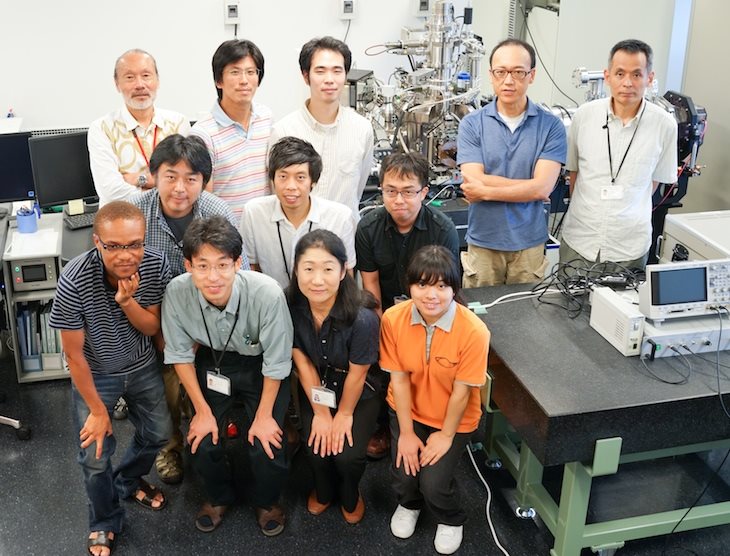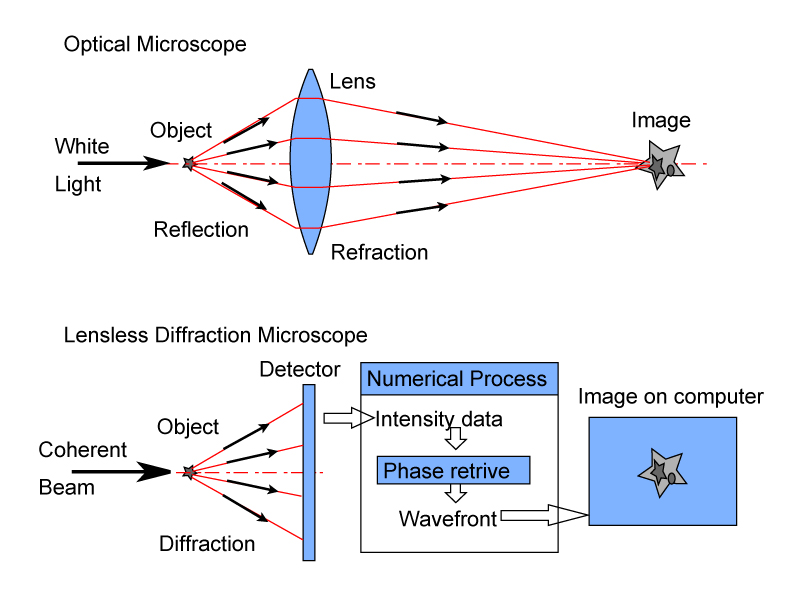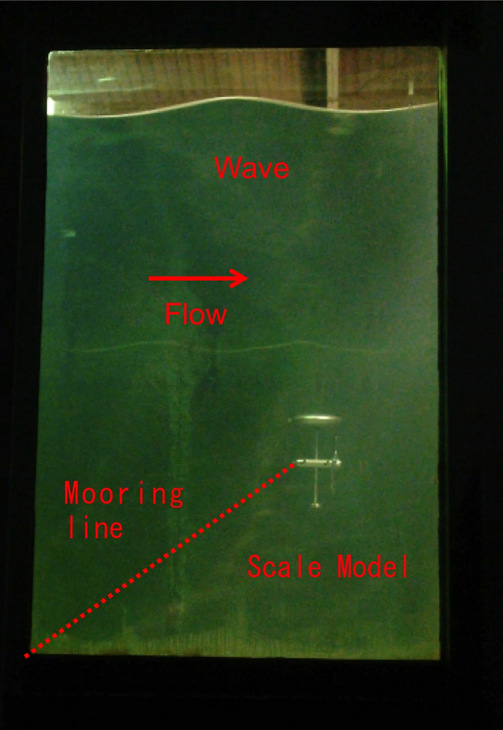FY2013 Annual Report
Quantum Wave Microscopy Unit
Professor Tsumoru Shintake

Abstract
1. R&D on diffraction electron microscope which uses the quantum wave interference associated with low energy electron as well as on the technique of electron holography. In FY2013 the unit has developed the electron spectrometer for diffraction pattern imaging. Viral-target preparation scheme and the technique for producing phase reconstructable holographic pattern are under development. Prior to 2013 the unit has developed a numerical technique for the holographic image reconstruction scheme, and diffraction electron microscope, DMF4000, in collaboration with HITACHI High Tech Science.
2. Our ocean current turbine will be moored from seabed to convert the kinetic energy of the marine current into electricity. So, a stability of the mooring system is an important issue to realize this power take off system. In order to verify the mooring system, we have developed a scale model of the OIST ocean current turbine. The scale mode was set in a circulation water channel. we have observed the stability of the floating body under various flow and wave conditions. The experimental results have demonstrated that the mooring system works stably.
1. Staff
- Dr. Katsutoshi Shirasawa, Staff Scientist
- Dr. Hidehito Adaniya, Postdoctoral Scholar
- Dr. Teruhisa Hirai, Staff Scientist
- Dr. Masao Yamashita, Postdoctoral Scholar
- Dr. Martin Philip Cheung, Postdoctoral Scholar
- Jun Fujita, Technician
- Junichiro Minami, Technician
- Chola Kalale, OIST PhD Student
- Ayumi Shimojima, Research Administrator
2. Collaborations
- Theme: Development of the ocean current turbine
- Type of collaboration: Joint research
- Researchers:
- Professor, Dr. Hidetsugu Iwashita, Hiroshima University
- Student, Kohei Tokunaga, Hiroshima University
3. Activities and Findings
3.1 Electron microscope group
Conceptual design of Diffraction electron microscope
In principle, by applying the method of iterative phase retrieval on coherent diffraction data, one can determine the phase of the diffraction beam, and reconstruct the real image of the sample object (Fig.3.1.1). This process works correctly if the object has a two dimensional structure. The phase of the diffraction beam from an object of three dimensional structure, however, cannot be determined uniquely. We have found that we may solve this problem by introducing holographic image reconstruction. To perform this experiment on biological sample, one may use an electron beam in low energy, below 1keV, to prevent the beam damage on the target sample. And the sample needs to be a thin enough to allow for the transmission of the diffracting electrons.

Fig.3.1.1: Concepts of normal optical microscope (single lens), and lensless diffraction microscope. We can totally eliminate the geometrical aberrations associated with magnetic lens, thus it will realize atomic resolution microscope.
Development of the electron diffraction microscope
The progress in FY2012 was the development of electron diffraction microscope, DMF4000, which is capable of SEM imaging and FIB fabrication. A technique of slicing out the sample target by FIB in few hundred nm was developed. The major progress in FY2013 was the development of electron spectrometer which is to obtain the diffraction patterns of scattered electron of smaller than few keV energy.
The essential features of the spectrometer is the 2dimensional detector of 8k x 8k CMOS sensors and electron optics system, which make possible to measure diffraction patterns in a large area produced by the Bragg angles of atomic scale spacing.
The unit is developing a technique to FIB-etch smaller than a few hundred nanometer scale test targets, compatible to the actual viral size, on metal coated TEM grids. Techniques of detecting the diffraction patterns from the test target, reconstructing the real images in stable manner, the viral sample preparation for low energy electron are currently under investigation.
Figure 3.1.2: OIST electron microscope; from left to right, DMF4000, electron diffraction spectrometer, F816 CMOS detector.

Figure 3.1.3: Fresnel fringe pattern of 30 micrometer aperture by 10keV electron beam, showing high coherency of the electron beam. The image is obtained by F816 CMOS detector.
3.2 Ocean Power Generation Group
Preparation of a scale model
In order to confirm a stability of the mooring system, we performed a circulating water channel test. We prepared a scale model of the ocean current turbine. Figure 3.2.1 shows a photograph and design drawing of the scale model. The rotor diameter is 250 mm. The scale model has a torque limiter in the nacelle instead of an electric generator. The float is made of a FRP to generate the buoyancy. We tuned a pitch angel of the blade to meet experimental condition.

Figure 3.2.1: Photograph and design drawing of the scale model.
Mooring experiment in a circulation water channel
The experiment was carried out at a circulation water channel of the West Japan Fluid engineering Laboratory Co., Ltd. The water channel is equipped with a wave generator. The test section is 48 m long, 4 m width and 1.6 m deep. A schematic diagram of the experimental setup is shown in Fig. 3.2.2. We set a load cell to measure a tension of the mooring line. The line was stainless steel wire of 0.3 mm diameter.
Figure 3.2.3 shows a photograph taken from the side transparent wall. The experimental results showed that our ocean current turbine works very stably.

Figure 3.2.2: A schematic diagram of the experimental setup.

Figure 3.2.3: Photograph of the mooring experiment in the circulation water channel.
4. Publications
4.1 Journals
- Shintake, T. Current status, challenges and future prospects of ocean current power generation, in Monthly Business i. ENECO Vol. 2013 Aug. 18-21 (2013).
4.2 Books and Other One-Time Publications
Nothing to report
4.3 Oral and Poster Presentations
- Shirasawa, K., Shintake, T., Tokunaga, K. & Iwashita, H. Development of an ocean current generator, in The Japan Society of Naval Architects and Ocean Engineers (JASNAOE) 2013 Annual Spring Meeting, International Conference Center Hiroshima (2013).
- Tokunaga, K., Iwashita, H., Shirasawa, K. & Shintake, T. A Study on Power Generation Characteristics of an Ocean Current Power Generation Turbine, in The Japan Society of Naval Architects and Ocean Engineers (JASNAOE) 2013 Annual Spring Meeting, International Conference Center Hiroshima (2013).
- Shirasawa, K. Development of an ocean current generator at OIST, in Kyushu University Research Institute for Applied Mechanics Symposium Ocean Renewable Energy Technologies, Kyushu University (2013).
5. Intellectual Property Rights and Other Specific Achievements
Nothing to report
6. Meetings and Events
6.1 Beam Physics Workshop 2013
- Date: November 28-30, 2013
- Venue: OIST Campus Center Bldg. Meeting Room, OIST Seaside House
- Organizer: Tsumoru Shintake, OIST
- Co-organizer: Atsushi Miyamoto, Hiroshima University
- Speakers:
- Masao Kuriki (Hiroshima University/KEK), "An optimization of Positron Injector of ILC"
- Junji Urakawa (KEK), "The status of conventional positron source for ILC"
- Yusuke Honda (KEK), "Commissioning of Compact-ERL injector"
- Tsukasa Miyajima (KEK), "Low emittance electron beam transportation from photocathode DC gun"
- Shigemi Sasaki (Hiroshima Synchrotron Radiation Center, Hiroshima University), "Recent Progress : Undulator Radiaton Carrying OAM"
- Keshav Dani (OIST), "Introduction to 4D Electron Microscopy"
- Jinfeng Yang (Osaka University), "MeV Electron Diffraction and Microscopy"
- Anusorn Lueangaramwong (Electron Light Science Center, Tohoku University), "Study of Longitudinal Phase Space Distribution Measurement via a Linear Focal Cherenkov Ring Camera"
- Hiroyuki Hama (Electron Light Science Center, Tohoku University), "Transverse Emittance Exchange for Smith-Purcell Backward-wave Oscillator FEL"
- Kei Fukushima (Hiroshima University Graduate School of Advanced Sciences of Matter), "Study of integer resonance crossing in non-scaling FFAGs with an ion trap system"
- Naoto Yamamoto (Nagoya University), "Beam injection study at aichiSR and UVSOR-III"
- Yoshihisa Iwashita (Kyoto University), "Thin Film on Bulk Conductor"
6.2 Seminars
Title: Exploring structured polymeric materials with electron tomography
- Date: July 29, 2013
- Venue: OIST Campus Lab1 Meeting Room
- Speaker: Hiroshi Jinnai, Ph.D. (Leader & Research Manager, JST ERATO Takahara Soft Interfaces Project, Research Professor, Institute for Materials Chemistry and Engineering, Kyushu University)
Title: Soil erosion on agricultural land and sediment management for agricultural watershed in Okinawa, Japan
- Date: October 17, 2013
- Venue: OIST Campus Lab1 Meeting Room
- Speaker: Kazutoshi Osawa, Ph.D. (Associate Professor of Faculty of Agriculture, Department of Environmental Engineering, Utsunomiya University)
Title: Structural and functional studies of the Type Ⅲ Secretion system of Shigella flexneri
- Date: October 30, 2013
- Venue: OIST Campus Lab1 Meeting Room
- Speaker: Martin Cheung, Ph.D.(Post-doctoral research assistant, University of Bristol)
7. Other
Nothing to report.



